National Chung-Shan Institute of Science and Technology
National Chung-Shan Institute of Science and Technology (NCSIST; Chinese: 國家中山科學研究院; pinyin: Guójiā Zhōngshān Kēxué Yánjiùyuàn) is a Taiwanese state owned corporation, formerly part of the Republic of China Ministry of National Defense's Armaments Bureau, which is active in the development, manufacturing, support, and sustainment of various weapons systems and dual use technologies.
Native name | 國家中山科學研究院 |
|---|---|
| Type | State Owned Enterprise |
| Industry | Defense and Manufacturing |
| Predecessor | Armaments Bureau |
| Founded | 1 June 1969 |
| Headquarters | , |
Key people | Chang Chung-Chung (張忠誠), (President)[1] |
| Products | Weapons systems and subsystems |
| Revenue | >1.7 billion USD[2] (2019) |
| Owner | Taiwanese Government |
Number of employees | ~10,000[3] (2019) |
| Website | www.ncsist.org.tw |
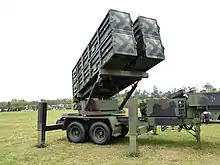
_20170309.jpg.webp)
Overview
NCSIST was established by the Republic of China government to serve as a military R&D and systems integration center. In 2014 it became an administrative corporation owned by the Government of Taiwan. NCSIST is involve in product development, manufacturing, delivery, total life cycle sustainment and maintenance.[4] NCSIST fulfills a function comparable to the American Defense Advanced Research Projects Agency (DARPA) but they also assume mixed roles in competing for and awarding research and development, integration and manufacturing contracts. Along with the Aerospace Industrial Development Corporation NCSIST it is considered to be one of the two Taiwanese prime defense contractors.[5]
History
Early history
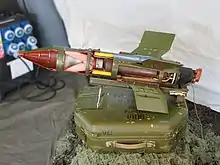
_underway_in_1952.jpg.webp)
Prior to the establishment of NCSIST, Taiwan had a poorly organized national defense industrial program, but the nation was faced with an increasing military threat from the People's Republic of China and a drawdown in international support and exclusion from international forums. The Republic of China would need to build its own set of hardware, instruments, laboratories, and test sites if it was to secure its independence and security.[6] Preparation for the NCSIST began in 1965, ground was broken on the Shinshin Campus in 1966, and the institute was formally inaugurated in 1969. Early work includes various missile and radar systems, as well as systems integration for ROC military aircraft and ships. The NCSIST was also, and remains, active in military construction.[7] After the United States switched diplomatic recognition from the Republic of China to the People's Republic of China the Institute became even more important as Taiwanese authorities felt they could no longer view the United States as a reliable defense partner.[4]
In the 1970s, the Institute replicated and produced the 9M14 Malyutka wire-guided anti-tank guided missile as the Kun Wu.[8] The ROC had obtained the 9M14 Malyutkas from South Vietnam. Due to the dated design and low priority placed on anti-tank weapons by the armed forces it was not widely adopted.[9] By the mid 1970s the Institute employed about 2,000 professionals.[10]
In the late 1970s the Institute embarked on a project to create a short-range ballistic missile prototype known as the Ching Feng. The project was intended as a pilot project to build the necessary skills needed for a long range missile program. The Ching Feng was a single stage missile which could carry a 450 kg warhead up to 110 km. The type was displayed publicly in 1981 but production was cancelled in 1982 because of significant problems with the solid rocket motor and the guidance system.[9] Overall the type resembled the American MGM-52 Lance. The follow on missile to, to be named Sky Horse, was also abandoned in 1981 under US pressure although interest in the type was revived in the 1990s after the Third Taiwan Strait Crisis.[10]
In the 1980s the Institute worked with Honeywell to design a distributed open architecture combat system to replace the obsolete MK 37 Gun Fire Control System aboard Taiwan's Gearing-class destroyers. This system, called the Modular Combat System (MCS), was the first distributed open architecture combat system in the world and featured easily upgradable COTS components. The system had challenges but did the job and was affordable with the architecture, computer, and software all being developed in Taiwan.[4]
In the 1990s Taiwan was faced with tightening restrictions on arms imports from the international community as well as instability caused by the transition from authoritarian to a democracy system. The Institute responded the these challenges by widening the scope of its R&D programs and implementing a system of vertical integration.[6] In the late 1990s NCSIST developed a space launch platform based on their ballistic missile technology but this program was put on hold under a combination of US pressure and a promise to subsidize Taiwanese satellite launches using commercial American companies such as SpaceX.[10]
In 2011 NCSIST awarded MiTAC a NT$70 million (US$2.22 million) contract to build one prototype “Radar Vehicle for Field Operation and Air Defense.” In 2015 police in Taoyuan took into custody three workers and one manager from MiTAC on charges of forgery of data and fabrication of test results. The tender required the vehicle to be able to advance at 8 km/h up a 40 degree incline, the vehicle MiTAC delivered could only advance at 6 km/h. In addition three NCSIST staff were detained on suspicion of colluding with the MiTAC employees to fabricate the test results, these staff then presented the fabricated results to their superiors for approval. The Taoyuan District Prosecutors’ Office began investigating after receiving a tip.[11]
Modern history
_in_2013.JPG.webp)

In 2014 NCSIST was made an administrative corporation by the government, ending its period of secrecy and opening up the opportunity to partner with foreign corporations and export equipment internationally.[12] The new corporate Board of Directors had their first meeting on April 18, 2014.[7] The transition removed a number of restrictions for employees who were now no longer members of the military.[13]
Due to the end of the US Navy’s support of the SM-1 missile system NCSIST has taken over support for the system including production of replacement rocket motors.[4] The same approach was taken for the SM-1’s Mark 13 missile launcher.[3]
In 2016 NCSIST was awarded a $16.7m contract to carry out a life extension program for the Republic of China Air Force’s stocks of MICA and Magic 2 air-to-air missiles. These two missiles arm the ROCAF’s Mirage 2000 fighter aircraft.[14]
In 2017 NCIST exhibited again at International Defence Exhibition in Abu Dhabi after a twelve year absence. They exhibited 39 items.[15]
In the mid 2010s NCSIST partnered with AIDC and the Republic of China Air Force (ROCAF) to create an advanced jet trainer based on the F-CK-1. AIDC is the prime contractor on the project with NCSIST taking a supporting role. Originally designated the XT-5 Blue Magpie but ruled out as the T-5 Brave Eagle the aircraft is based on the two-seat version of the F-CK-1 but with non-afterburning engines, greater fuel capacity, more stable wing profile, and the removal of the internal gun. The first of four prototypes, designated A1, was rolled out in September 2019.[16] Low rate production is intended to commence in 2021 with mass production beginning in 2023.[17]
NCSIST is participating in the development of the first domestic Taiwanese AUV.[18] In 2019 NCSIST launched an 80-ton 28m long high speed catamaran research and test vessel named the Glorious Star (光榮之星). Built in the Lungteh Shipbuilding in Yilan County the purpose of the vessel is to shorten the research and development process for naval weapon systems.[19]
In 2019 Taiwanese President Tsai Ing-wen ordered the NCSIST to accelerate mass production of the TK-3 and HF-3 in response to increasing Chinese military power and bellicosity. In addition to stepping up missile production the President also ordered NCSIST leadership to focus building up their talent pool and increase partnerships with academia, industry and government at home and abroad.[20] Mass production of the long-range Yun Feng supersonic cruise missile began in 2019.[21]
In 2019 NCSIST opened Taiwan’s first national unmanned aerial vehicle test site in Miaoli County. The test site is managed in partnership by NCSIST, the Miaoli County government, and the Ministry of Transportation and Communications (Taiwan). The site features a 20m runway and is rated for testing UAVs up to 150 kg in weight.[22] They also entered into an agreement with Asustek Computer Inc to collaborate on cloud-based storage, artificial intelligence, and Internet of Things technology.[23]
In November 2019 NCSIST tested a new short range anti-ship missile from the Glorious Star which while weighting significantly less than the Hsiung Feng II is said to have the same range.[24]
In March 2020 NCSIST conducted live fire daytime and nighttime artillery and UAV detection tests which where observed by a People's Liberation Army Navy Hsiang Yang Hung-class survey vessel.[25]
In April 2020 Chang Chung-Cheng (張忠誠) replaced Gao Chung-Hsing (杲中興) as the president of NCSIST. Gao had courted controversy by deliberately misinterpreting The Classified National Security Information Protection Act. Chang Chung-Cheng is a retired major general who served in the Combined Logistics Command as well as the Armaments Bureau.[1]
In July 2020 NCSIST was awarded a NT$4.8 billion (US$163 million) contract to produce 516 sets of secure high frequency radios for the Taiwanese military. The military side of the contract will be handled by the Navy with a deadline for delivery in late 2023.[26]
WMDs
The institute developed nuclear weapons during the Cold War. In 1967, a nuclear weapons program began under the auspices of the Institute of Nuclear Energy Research (INER) of CSIST. After the International Atomic Energy Agency found evidence of the ROC's efforts to produce weapons-grade plutonium, Taipei agreed in September 1976 under U.S. pressure to dismantle its nuclear weapons program. Though the nuclear reactor was soon shut down and the plutonium mostly returned to the U.S., a secret program was revealed when Colonel Chang Hsien-yi, deputy director of nuclear research at INER, defected to the U.S. in December 1987 and produced a cache of incriminating documents. At present there is no claim that any nuclear weapons program is being pursued.[27]
Developed weapons systems
Aircraft
- AIDC F-CK Indigenous Defence Fighter: Developed by division later spun off as AIDC and was a contractor also.[28] Worked with AIDC to provide upgrades for the IDF.[29]
- AIDC AT-3 Tz-chiang Advanced Trainer[30]
- AIDC T-5 Brave Eagle jet trainer/lead-in trainer developed in partnership with AIDC and Republic of China Air Force. Based on F-CK-1 B/D.[16]
- NCSIST Albatross Tactical Unmanned Aircraft System:[31] In January 2019 the Albatross participated in its first large scale combat exercise.[32][33]
- NCSIST Teng Yun (Cloud Rider) Unmanned Aircraft System: MALE analogous to the US MQ-9.[34][35][36] Unveiled in 2015.[37]
- NCSIST Cardinal, family of small UAVs. Includes Cardinal I, Cardinal II, and Fire Cardinal.[38]
- NCSIST Chien Hsiang: First exhibited in 2017, visually similar to IAI Harpy.[39] In 2019 the Taiwan Air Force’s Air Defense and Missile Command announced a five year, NT$80b (US$2.54b) project to build up a full force of anti-radiation UAVs.[40] The anti-radiation drone has a reported loiter time of 100 hours and a top speed of 185 km/h.[41]
- NCSIST Spark: target drone.[42]
- NCSIST Flamingo II: target drone.
 IDF with Wan Chien
IDF with Wan Chien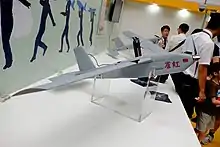 NCSIST Cardinal UAV
NCSIST Cardinal UAV NCSIST Teng Yun on Display at Hsinchu Air Force Base
NCSIST Teng Yun on Display at Hsinchu Air Force Base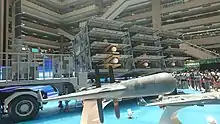 NCSIST Chien Hsiang loitering munition and launcher
NCSIST Chien Hsiang loitering munition and launcher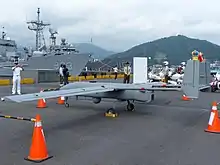 NCSIST Albatross 9717 on display at No.11 Pier
NCSIST Albatross 9717 on display at No.11 Pier NCSIST Spark Target Drone Display at MND Hall
NCSIST Spark Target Drone Display at MND Hall Flamingo II
Flamingo II
Missile systems
- Hsiung Feng I (HF-1): Surface launched subsonic Anti-ship missile.[43]
- Hsiung Feng II (HF-2): surface launched subsonic anti-ship missile with limited air-to-ground missile capabilities.
- Hsiung Feng IIE (HF-2E): surface launched long range cruise missile system
- Hsiung Feng III (HF-3): surface launched supersonic anti-ship missile.[44]
- Sky Bow (TK): Air defense weapon system, consists of TK-1, TK-2, and TK-3 systems.[45]
- Sky Sword I (TC-1): IR guided short range air-to-air missile.[46]
- Antelope air defence system: road mobile SHORAD system built around the TC-1.[46]
- Sea Oryx: sea based point defense system built around the TC-1.[47]
- Sky Sword II (TC-2): radar guided medium range air-to-air missile.[48]
- Sky Horse: short range ballistic missile system developed in the 1970’s.
- Sky Spear: short range ballistic missile system derived from the TK-2.
- Yun Feng: supersonic surface-to-surface cruise missile.[49]
- Wan Chien: Air-ground cruise missile.[50]
 Tien Kung Ⅲ (TK-3) Missile Launcher Trailer
Tien Kung Ⅲ (TK-3) Missile Launcher Trailer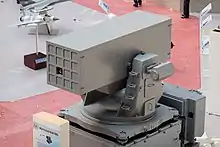 Sea Oryx Missile Launcher
Sea Oryx Missile Launcher Antelope Air Defense System at CCK Air Force Base
Antelope Air Defense System at CCK Air Force Base Hsiung Feng II Anti-Ship Missile
Hsiung Feng II Anti-Ship Missile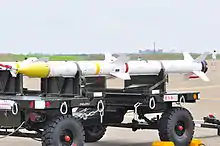 TC-2 (Sky Sword II)
TC-2 (Sky Sword II)
Other weapon systems
- Thunderbolt-2000 (LT-2000): locally developed MLRS.[51]
- Kung Feng 6 (KF 6): locally developed MLRS.[43]
- Kestrel (rocket launcher): Disposable rocket launcher firing HEAT and HESH projectiles. Development began in 2008.[52] The Kestrel entered service with the ROCMC in 2015.[53] The Kestrel platform is being used as a starting point for the development of an anti-tank guided missile system.[54]
- XTR-101/102: Automatic close-defense 20mm weapon mounts. Prototypes demonstrated in September 2013.[55] Exhibited for the first time in 2015.[56]
- CS/MPQ-90 Bee Eye: short-medium range multifunction AESA radar to support SHORAD batteries. Planned to have a naval role as well.[57]
- Bistatic Radar system: Bistatic radar system.[58] Two systems entered service in 2018 with mass production to begin in 2020 if they behave favorably in the field.[59][60]
- AV2 Long-range Chaff Rocket: Chaff (countermeasure) rocket for ship self defense.[61]
- 2.75in rocket: 2.75 inch aerial rocket for use aboard AH-64, OH-58D, F-5E/F, F-16, P-3 Orion, etc. Two variants, Mk4 and Mk66.[62]
- CAPTOR mine: Designated No.1 Wan Xiang CAPTOR Mine. CAPTOR mines contain a torpedo and a targeting system.[63][64][65]
- Bottom mine: Designated No.2 Wan Xiang Bottom Mine. A remote controlled or passive mine designed to sit on the bottom.[63][65] Designated WSM-II, smart mine for use in deep water.[66]
- Moored mine: A remote or automatic mine designed to be moored to the bottom and float in the current.[63]
 Short range AESA radar system (CS/MPQ-90 Bee Eye)
Short range AESA radar system (CS/MPQ-90 Bee Eye) Bistatic Radar Passive Receiver Systen Display at Military Academy Ground
Bistatic Radar Passive Receiver Systen Display at Military Academy Ground_20151024.jpg.webp) No.1 Wan Xiang CAPTOR Mine
No.1 Wan Xiang CAPTOR Mine_20151024a.jpg.webp) No.2 Wan Xiang Bottom Mine
No.2 Wan Xiang Bottom Mine MK.6 Mine
MK.6 Mine Coastal defense rocket launcher
Coastal defense rocket launcher ROC marines with Kestrel rocket
ROC marines with Kestrel rocket Thunderbolt-2000 MLRS Display at CKS Memorial Hall
Thunderbolt-2000 MLRS Display at CKS Memorial Hall
Civilian systems
- Sensor system for the Resource Prospector lunar rover mission. Cancelled in 2018.[67] The instruments will be flown aboard the Commercial Lunar Payload Services missions in the 2020s.[68]
- SG100 Cloud Computer for the International Space Station designed and manufactured in collaboration with Academia Sinica and National Central University under contract for NASA.[69] It was launched to the space station in 2017.[67]
- High speed rail simulator developed with Taiwan High Speed Rail. Based on aircraft simulator technology the system can simulate natural disasters such as typhoons and earthquakes.[70]
- Civilian air traffic control radar: NCSIST has partnered with British firm Easat Radar Systems to pursue dual use projects using NCSIST’s proprietary radar technology.[71]
- Major components for the European Extremely Large Telescope (E-ELT), first prototype segments delivered in 2020.[72]
 Artist’s impression of the European Extremely Large Telescope deploying lasers for adaptive optics
Artist’s impression of the European Extremely Large Telescope deploying lasers for adaptive optics
Organization
The institute is divided into six research divisions and five centers.[73] Research divisions pursue both project oriented and basic scientific research.[4]
Research Divisions
- Aeronautical Systems
- Missile and Rocket Systems
- Information and Communications
- Chemical Systems
- Materials and Electro-Optics
- Electronic Systems
Centers
- System Development
- System Manufacturing
- Systems Sustainment
- Integrated Logistical Support
- Dual-Use Technology Development
Locations
NCSIST facilities are located in Taoyuan (four facilities), New Taipei City, Taichung City, Kaohsiung, and Pingtung County.[74]
See also
References
- Cheng, Ching-Tse. "Taiwan military research institute announces new president". www.taiwannews.com.tw. Taiwan News. Retrieved 19 April 2020.
- Cheng, Jiawen. "Missiles start ... Chinese Academy of Sciences's turnover reached 50 billion yuan last year". udn.com. United Daily News. Retrieved 19 January 2020.
- LUNDQUIST, EDWARD. "Neighborhood Problems in the Taiwan Strait". indsr.org.tw. INDSR. Retrieved 5 December 2019.
- Lundquist, Edward W. "nterview with Adm. Richard Chen, Republic of China Navy (Ret.)". Defense Media Network. Retrieved 2 August 2019.
- Du, Eric. "VIEWPOINT: Business Opportunities for U.S. Defense Firms Abound in Taiwan". www.nationaldefensemagazine.org.
- "NCSIST: Always adapting to an ever-changing world". GMI Post. Retrieved 2 August 2019.
- "History". NCSIST.
- "Malyutka". Military Today. Retrieved 28 August 2019.
- "Taiwan's Modest Defense Industries Program" (PDF). Central Intelligence Agency. Retrieved 28 August 2019.
- Dinshaw Mistry (20 June 2013). Containing Missile Proliferation: Strategic Technology, Security Regimes, and International Cooperation in Arms Control. University of Washington Press. p. 97. ISBN 978-0-295-80252-7.
- Pan, Jason. "Four detained in military radar scandal". Taipei Times. Retrieved 8 August 2019.
- Pocock, Chris. "Taiwan's Good Technical Offer Is Affected By Politics". AIN Online. Retrieved 7 June 2019.
- Tu, Aaron; Chung, Jake. "Amendments aim to restrict institute staff travel: source". www.taipeitimes.com. Taipei Times. Retrieved 12 April 2020.
- Yeo, Mike. "Taiwan fighter jets get new electronic warfare capabilities in latest upgrade". Defense News. Retrieved 30 August 2019.
- "Packing a punch [IDEX17D3]". Janes. Retrieved 30 August 2019.
- Choo, Roy. "PICTURE: Taiwan unveils "Brave Eagle" AJT". Flight Global. Retrieved 7 October 2019.
- Lake, Jon. "Taiwan Unveils New Advanced Trainer". AIN Online. Retrieved 8 October 2019.
- Chen Chih-chong and, Kuan-lin Liu. "Taiwan plans to launch its first indigenous AUV within 5 years". Focus Taiwan. Retrieved 14 May 2019.
- Strong, Matthew. "Taiwan launches military test ship". Taiwan News. Retrieved 21 April 2019.
- Wen Kuei-hsiang and, FLor Wang. "Taiwan president urges faster mass production of missiles". Focus Taiwan. Retrieved 18 May 2019.
- Axe, David. "BOOM: Why China Should Take Taiwan's New Cruise Missile Seriously". Yahoo News. Retrieved 8 October 2019.
- DeAeth, Duncan. "Taiwan opens first national drone testing site". Taiwan News. Retrieved 7 October 2019.
- "Taiwan Business Quick Take". Taipei Times. Retrieved 8 October 2019.
- Lao, George. "Taiwan tests new anti-ship missile". www.taiwannews.com.tw. Taiwan News. Retrieved 6 December 2019.
- Chen, Kelvin. "Taiwan Air Force and NCSIST conduct live fire exercises". www.taiwannews.com.tw. Taiwan News. Retrieved 12 April 2020.
- Strong, Matthew. "Taiwan military budgets NT$4.8 billion for high-frequency communication system". www.taiwannews.com.tw. Taiwan News. Retrieved 18 July 2020.
- Mizokami, Kyle. "China's Greatest Nightmare: Taiwan Armed with Nuclear Weapons". The National Interest. Retrieved 2017-03-12.
- Aerospace Industrial Development Corporation (AIDC). Retrieved on May 11, 2008.
- Taiwan Seeking a Better F-CK, With Possible Longer-Term Aspirations. Retrieved on May 11, 2008.
- "AT-3 Tz-chiang Advanced Trainer". NCSIST. Retrieved 2017-03-16.
- "Albatross Tactical Unmanned Aircraft Systems". NCSIST. Retrieved 2017-03-16.
- "Taiwan's Navy first fly-over demonstration using the Albatross UAV". Navy Recognition. Retrieved 1 July 2019.
- Keck, Zachary. "Taiwan's Using Drones to Spy on China". The Diplomat. Retrieved 17 July 2019.
- Axe, David. "Coming Soon: Killer Drones from Taiwan (That China Will Hate)?". The National Interest. Retrieved 18 July 2019.
- Strong, Matthew. "Taiwan tests largest domestic drone above Taitung". Taiwan News. Retrieved 18 July 2019.
- "Taiwan to form fleet of armed unmanned aerial vehicles (UAVs) to patrol its coastline". Military & Aerospace Electronics. Retrieved 18 July 2019.
- Cole, J. Michael. "Taiwan Unveils New Long-Endurance Drone, New Weapons at Defense Trade Show". The Diplomat. Retrieved 18 July 2019.
- "Cardinal Mini Unmanned Aircraft Systems". NCSIST. Retrieved 2017-03-16.
- Cole, J. Michael. "How Taiwan Can Defend Its Coastline Against China". National Interest. Retrieved 13 July 2019.
- Liao, George. "Taiwan military to spend NT$80 billion on anti-radiation drone fleet". Taiwan News. Retrieved 22 June 2019.
- Cole, J. Michael. "Taiwanese Military Unveils New Equipment at Defense Trade Show". Taiwan Sentinel. Retrieved 2 August 2019.
- "Spark Target Drone". www.ncsist.org.tw/. NCSIST. Retrieved 17 January 2020.
- Chungshan Institute of Science and Technology. Retrieved on May 11, 2008.
- "HF Ⅲ Supersonic Anti-Ship Missile". NCSIST. Retrieved 2017-03-13.
- "Tien-Kung (Sky Bow)". Missile Defense Advocacy Alliance. Retrieved 23 July 2019.
- "The Antelope". Missile Defense Advocacy Alliance. Retrieved 21 April 2019.
- "Sea Oryx". Missile Defense Advocacy Alliance. Retrieved 21 April 2019.
- "Tien Chien-2N (TC-2N)". Missile Defense Advocacy Alliance. Retrieved 23 July 2019.
- "Taiwan to aim missiles at China". NewsComAu. Retrieved 2017-03-13.
- Cole, J. Michael. "Taiwan Unveils 'Wan Chien' Air-To-Ground Cruise Missile". The Diplomat. Retrieved 2017-03-16.
- "Ray-Ting 2000 Artillery Multiple Launch Rocket System". NCSIST. Retrieved 2017-03-13.
- "Kestrel latest generation of rocket launcher weapon presented by Chung-Shan Institute TADTE 1908136". armyrecognition.com. 19 August 2013.
- "Kestrel Rocket". NCSIST. Retrieved 1 July 2019.
- Lo Tien-pin; Jake Chung (Mar 31, 2018). "US, Taiwan sign missile deal: source". Taipei Times. Retrieved 1 July 2019.
- "New short-range automated defense weapon systems XTR-101 and XTR-102 at TADTE 2013 1608133". armyrecognition.com. 15 August 2013.
- Minnick, Wendell. "Taiwan Defense Show Exhibits New Weapons". Defense News. Retrieved 6 May 2019.
- Yeo, Mike. "Taiwan's Navy seeks first indigenous landing platform dock". Defense News. Retrieved 2 August 2019.
- "New local-made Bistatic Radar - Passive Receiver System of Taiwanese army for coast surveillance 250". armyrecognition.com. 25 August 2013. Retrieved 17 May 2019.
- Everington, Keoni. "Taiwan field testing new mobile passive radar systems to hunt Chinese stealth fighter jets". Taiwan News. Retrieved 2 August 2019.
- "Mobile Passive Radar Systems". NCSIST. Retrieved 2 August 2019.
- "AV2 Long-range Chaff Rocket". NCSIST. Retrieved 16 July 2019.
- "2.75 Inch Rocket". NCSIST. Retrieved 16 July 2019.
- "Mine". NCSIST. Retrieved 16 July 2019.
- THOMPSON, DREW. "HOPE ON THE HORIZON: TAIWAN'S RADICAL NEW DEFENSE CONCEPT". War on the Rocks. Retrieved 16 July 2019.
- TREVITHICK, JOSEPH. "Taiwan's Next Batch Of Stealthy Catamarans Will Have Serious Mine-Laying Capabilities". The Drive. Retrieved 16 July 2019.
- Chang, Eric. "Taiwan Navy conducts mine drills amidst increasing Chinese military activity". www.taiwannews.com.tw. Taiwan News. Retrieved 6 July 2020.
- An, David. "US-Taiwan Space Cooperation: Formosat, AMS, and the ISS computer". Global Taiwan Institute. Retrieved 17 June 2019.
- Stuckey, Alex. "NASA spent $100 million on much-anticipated lunar rover before scrapping it in April". Chron. Retrieved 17 June 2019.
- Jonathan Chin, Lo Tien-pin and. "Taiwan-designed computer now part of an ISS mission". Taipei Times. Retrieved 17 June 2019.
- Tzu-ti, Huang. "Taiwan hails home-built locomotive simulator as milestone for rail industry". Taiwan News. Retrieved 28 May 2019.
- "Taiwan's top defense R&D outfit to work with UK radar tech company". Taiwan Today. Retrieved 2 August 2019.
- Wallace, John. "Aspheres: Industry 4.0 techniques drive fabrication of prototype off-axis ELT mirrors". www.laserfocusworld.com. Laser Focus World. Retrieved 20 February 2020.
- "Organization". NCSIST. Retrieved 23 July 2019.
- "Locations". NCSIST. Retrieved 23 July 2019.
External links
External links
| Wikimedia Commons has media related to National Chung-Shan Institute of Science and Technology. |
